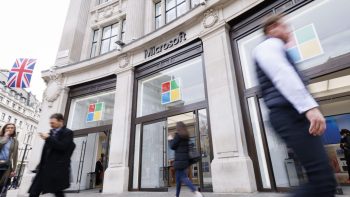Kai Ryssdal: There was a small but significant shift in the personal computing ecosystem today. Microsoft gave the world its first official look at the new version of the Windows operating system — Windows 8, technically. And for the first time in 15 years there’s a key piece of it missing: that little Start button on the task bar isn’t there anymore.
Commentator Jennifer 8. Lee says it’s a sign we’re maturing — right alonside our technology.
Jennifer 8. Lee: We first saw it with Windows 95. It was the dawn of the networked age, and the Start button was a beacon for those of us stumbling around the maze of folders and programs on our computers. You could look and there it was — in bold simple letters in the corner — “Start.” It was a noun, an imperative command, a portal, all in one.
Microsoft had always been knocked as a copycat of other people’s ideas, but the Start button was the Seattle giant’s own invention. Indeed, patent number 5920316 was granted on July 6, 1999 to Microsoft for “Taskbar with start menu.” As the patent explains. “The start menu acts as a centralized place for a user to gain access to programs, documents, system settings, help information and the like.” Don’t remember where you saved that spreadsheet for work? The Start button was there to help. Sick of your screensaver? The Start button would guide you to the control panel, like an usher showing you to your seat. Thus, for millions, the Start button was computing on training wheels.
Lest we get too nostalgic, we should acknowledge that the Start button has long been on the decline. In Windows Vista, the Start button had been displaced by a shiny Windows logo. But the the sentimental-minded still could delve into the settings and choose the “Windows classic” look to revive it. In Windows 8, the button is gone.
Of course, computing has come a long way since those “classic” days of yore. Back then, a computer was a bulky desktop with a dial-up modem, floppy disk drive and a cathode ray tube monitor. Now our computers fit in our pockets and have 4G connectivity, gigabytes of flash memory, and touch screens. In the age of cloud computing and constant connectivity, the stop and pause functions on our gadgets and media players have become one in the same. When things are always on, we no longer have to start them.
Ryssdal: Jennifer 8. Lee is the author “The Fortune Cookie Chronicles.” Send us your thoughts — write to us.
There’s a lot happening in the world. Through it all, Marketplace is here for you.
You rely on Marketplace to break down the world’s events and tell you how it affects you in a fact-based, approachable way. We rely on your financial support to keep making that possible.
Your donation today powers the independent journalism that you rely on. For just $5/month, you can help sustain Marketplace so we can keep reporting on the things that matter to you.


















